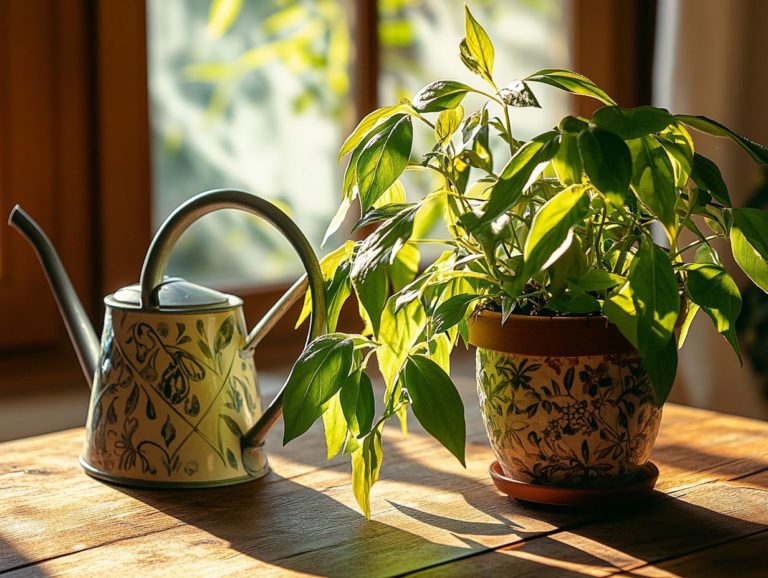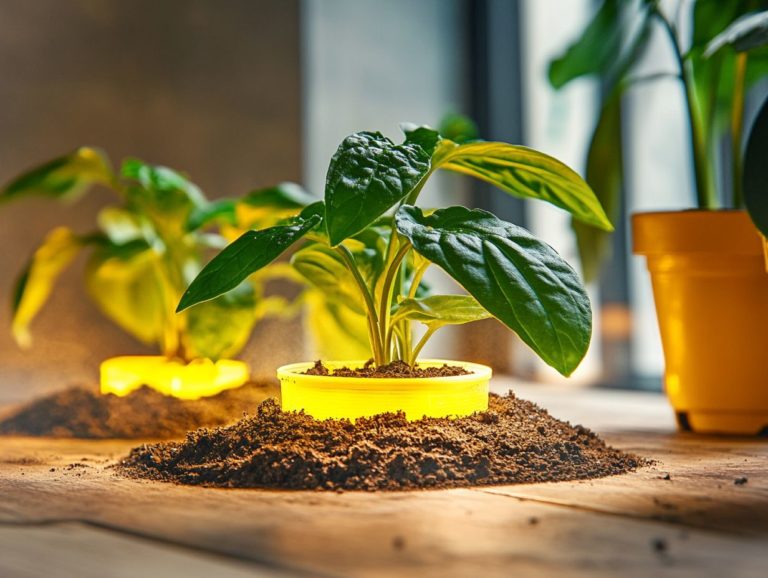How Can I Make My Indoor Plants Grow Faster?
Are you ready to witness your indoor plants flourish? This guide will help you grasp the key factors that influence plant growth.
Understanding these factors is vital for creating a vibrant indoor garden and optimizing your plant care.
From providing the right light and water to ensuring ideal nutrients and temperature, each element is essential for success. This guide will empower you to choose fast-growing plants and utilize effective techniques like fertilizing and pruning.
Dive into practical tips that will enhance your indoor gardening skills! Enjoy the lush, thriving greenery that will grace your home.
Contents
- Key Takeaways:
- Factors That Affect Plant Growth
- Choosing the Right Plants for Fast Growth
- Providing Optimal Growing Conditions
- Fertilizing for Faster Growth
- Pruning and Trimming for Growth
- Additional Tips for Promoting Fast Growth
- Frequently Asked Questions
- How Can I Make My Indoor Plants Grow Faster?
- Which Fertilizers Help My Indoor Plants Thrive?
- Is Pruning Necessary for Faster Growth?
- Can I Use Artificial Light to Help My Indoor Plants Grow Faster?
- How Often Should I Water My Indoor Plants?
- What Common Mistakes Might Be Hindering My Indoor Plants’ Growth?
Key Takeaways:
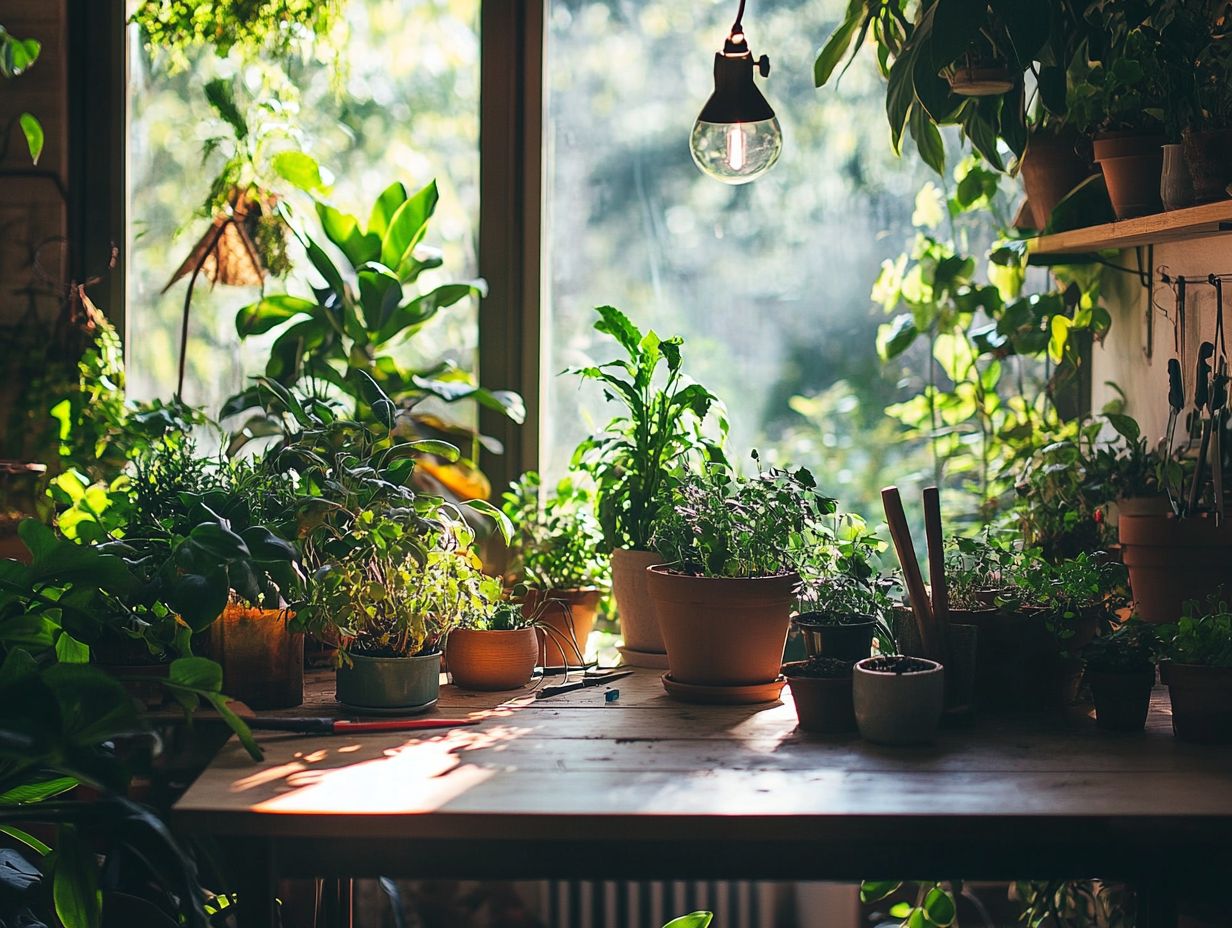
Factors That Affect Plant Growth
Factors that significantly influence plant growth include light exposure, consistent watering, nutrient availability, temperature regulation, and humidity levels.
Understanding these components is crucial for houseplant enthusiasts eager to enhance the growth of indoor plants like Peace Lilies and Jade Plants.
Successful indoor plant care relies on a delicate balance of these factors, allowing your beloved houseplants to thrive.
Light, Water, Nutrients, and Temperature
The four fundamental aspects of plant growth light, water, nutrients, and temperature interact dynamically, influencing the health of your houseplants.
Consider light. The ideal conditions can differ dramatically; while succulents bask in bright sunlight, ferns prefer indirect light to preserve their vibrant foliage.
When it comes to watering, check the soil moisture regularly. It should stay damp, but not soggy, as excess moisture can lead to root rot, when roots decay due to excessive wetness.
Nourishment is also key. Choose organic fertilizers like worm castings or fish emulsion, which can boost growth by providing essential nutrients without harsh chemicals.
Understanding the humidity and temperature needs of your plants is crucial. Plants like tropical varieties thrive in higher humidity levels. Consider misting the leaves or using a humidifier to create a perfect microclimate, and don t forget to rotate plant pots for better light exposure.
Choosing the Right Plants for Fast Growth
Selecting the right plants for rapid growth is essential for anyone eager to elevate their indoor gardening game.
By choosing species that flourish in specific conditions and utilizing effective techniques, you can enhance your houseplant growth and transform your space into a vibrant oasis.
Whether you choose fast-growing tropical varieties like Peace Lilies or the low-maintenance charm of Jade Plants, understanding the growth habits of different plants will enrich your indoor gardening journey.
Embrace the satisfaction of nurturing a lush, thriving environment right in your home.
Types of Plants and Their Growth Rates
Different types of houseplants showcase a variety of growth rates. Understanding these can empower you to select the right plants for swift results. If you re eager to fill your space quickly, fast-growing species like pothos and spider plants are excellent choices. If you prefer a more laid-back approach, succulents and cacti might take a bit longer but require less maintenance.
Grasping the growth rates of these houseplants is essential for using good indoor gardening practices that nurture their development.
Medium growers, such as snake plants and Peace Lilies, strike a harmonious balance. They thrive with just the right amount of attention and flourish in indirect sunlight, making them perfect for rooms that don t get plenty of natural light. Clean plant leaves promote photosynthesis.
You should pay attention to light exposure too. While most houseplants favor bright, indirect sunlight, others, like ferns, flourish in higher humidity levels.
To maintain a diverse collection, regularly monitor moisture levels and adjust your watering schedules based on each plant’s needs. Cluster them together to create a mini-ecosystem that elevates humidity. This ensures that all varieties thrive in perfect harmony while avoiding overwatering.
Providing Optimal Growing Conditions
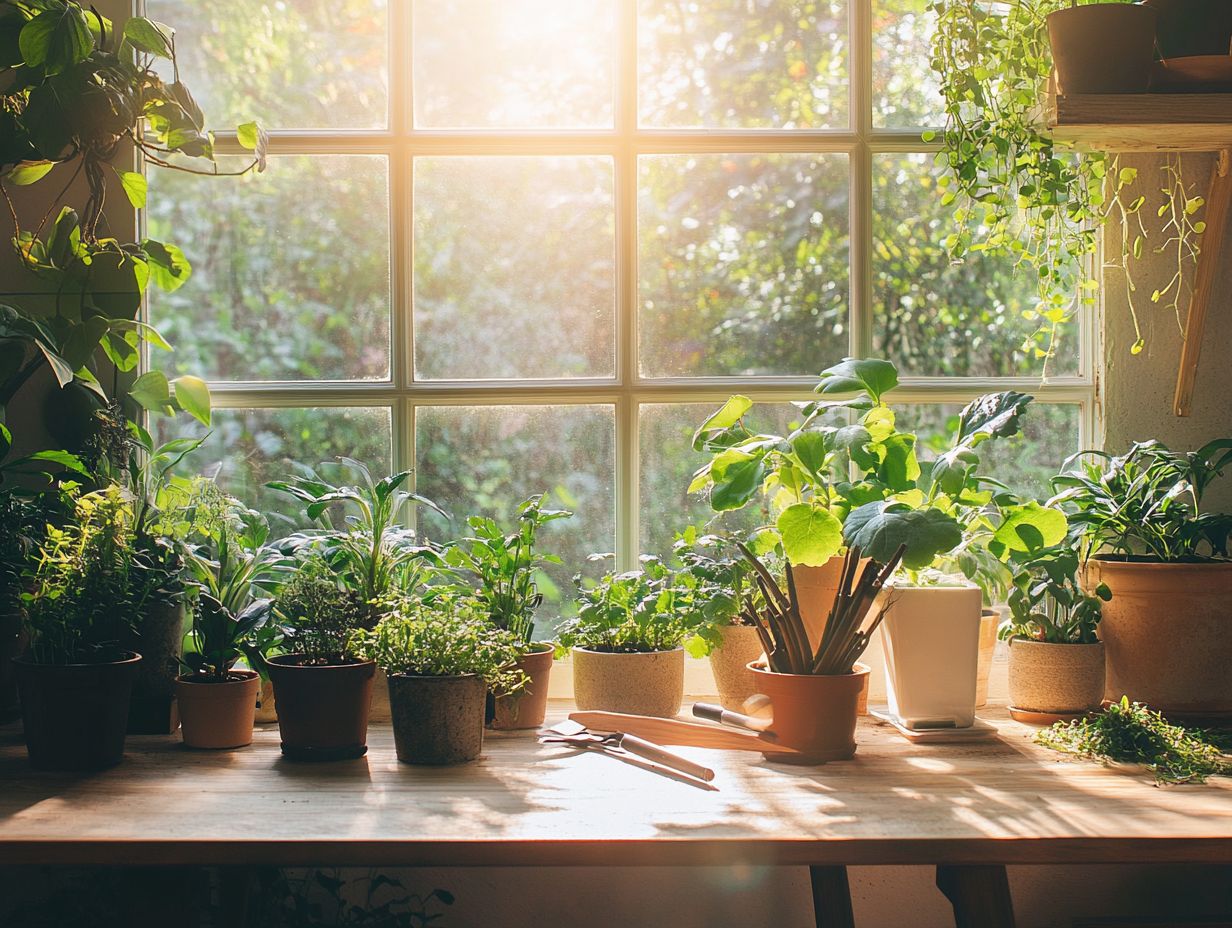
Creating the perfect environment for growth is essential in nurturing healthy indoor plants. Pay careful attention to key factors like humidity levels, light exposure, and soil quality improvement. As a houseplant enthusiast, you can optimize your gardening techniques to cultivate conditions where your plants truly thrive.
Ensuring that your plants receive adequate light while effectively managing humidity levels can significantly enhance photosynthesis and growth rates. It s crucial to understand the specific needs of each plant to achieve the best results.
Creating a Suitable Environment for Growth
Creating the perfect environment for your plants involves balancing several key elements. Maintain consistent watering, control temperature, and ensure a stable environment. Be aware of how these factors affect plant health and growth rates, allowing you to adapt your care routines to meet the unique needs of each species.
By regularly monitoring temperature levels and adjusting your watering schedule, you can significantly enhance the vitality of your indoor plants.
Utilizing methods such as the finger test for soil moisture or investing in a humidity meter allows you to adjust your watering easily. This prevents the pitfalls of overwatering or underwatering, which can lead to stress and diseases, especially when managing plant pests.
Understanding the ideal temperature range for your specific plants is crucial. Keeping tropical varieties like monstera in consistently warm environments encourages robust growth, while succulents thrive better with cooler nights.
Adjusting window placements or using grow lights can ensure that each plant gets the adequate light and warmth it needs. This ultimately fosters a thriving ecosystem right in your living space, contributing to indoor air purification. Additionally, learning how to trim indoor plants for better growth can further enhance their health and vitality.
Fertilizing for Faster Growth
Fertilizing your houseplants effectively is essential for fostering rapid growth and maintaining their overall health. Indoor plants often miss out on the natural nutrients they would find outdoors, such as those in compost, banana peels, and carbonated water.
To achieve this, consider incorporating a range of organic fertilizers into your plant care routine. Options like compost, banana peels, compost tea, and Epsom salt deliver vital nutrients while avoiding chemical buildup.
By mastering the application of these methods, you can elevate the vitality of your plants, ensuring they not only survive but thrive and flourish in your care.
Types of Fertilizers and Application Methods
Know the types of fertilizers and how to apply them to nourish your houseplants, including organic fertilizers. With this knowledge, you’ll supercharge your plants growth!
Organic fertilizers, such as Epsom salt and garlic skins, offer unique benefits for indoor plants. They enhance soil quality and stimulate growth when applied correctly. Choosing the right fertilizer and knowing when and how to apply it can significantly improve your plants health and vigor.
Synthetic fertilizers deliver concentrated nutrients for rapid results. Water-soluble formulas can easily blend into your regular watering routine, making nutrients readily available for your plants.
Apply fertilizers during your plant s active growth phase for the best results. Avoid late-season applications to prevent nutrient runoff. Techniques like foliar feeding applying nutrients directly to leaves can enhance nutrient absorption, promote healthier growth, and help manage plant pests.
Pruning and Trimming for Growth
Learn when and how to prune your plants to keep them healthy and promote robust foliage development. Understanding these practices is crucial for anyone passionate about indoor gardening.
Timely pruning promotes growth and reduces the risk of pests and diseases. By mastering effective pruning techniques, you can cultivate a vibrant indoor garden filled with thriving houseplants.
How and When to Prune and Trim Plants: A Guide for Houseplant Enthusiasts

Understanding how and when to prune and trim your plants is essential for achieving optimal growth. Mastering proper pruning techniques allows you to shape your plants, remove dead or damaged leaves, and encourage new growth. Knowing the right timing ensures your efforts yield the best results.
Whether you’re just starting or are a seasoned houseplant aficionado, honing these skills will elevate your indoor gardening game.
Recognize the specific needs of each plant species. Some thrive with optimal light exposure during the growing season, while others benefit from more extensive pruning in early spring. For instance, tropical houseplants often benefit from selective leaf removal, improving airflow and allowing for better light penetration for photosynthesis. To learn how to adjust light for indoor plant growth, check out this helpful guide. Meanwhile, succulent varieties don’t require frequent pruning; maintaining their shape is usually sufficient.
Use sharp, clean tools to keep your plants healthy. Assess your plant’s health before making any cuts. This thoughtful approach fosters a more resilient garden. By following these practical tips, you can ensure that your indoor plants, like Peace Lilies and Jade Plants, not only survive but truly thrive.
Additional Tips for Promoting Fast Growth
Implementing extra tips for promoting rapid growth can profoundly enhance the health and vitality of your houseplants, particularly if you’re a busy indoor gardener. Simple care techniques, like the bottom watering method and cleaning plant leaves, can significantly boost photosynthesis and bolster your plants’ resilience.
Taking a proactive stance on pest management is crucial for protecting your indoor garden and ensuring your houseplants flourish over time.
Care and Maintenance Techniques
Adopting effective care and maintenance techniques is crucial for nurturing your indoor plants. This lays a strong foundation for their growth and health through careful soil quality improvement and compost use. Key practices include monitoring humidity levels, ensuring consistent watering, and employing specific indoor gardening techniques tailored to each species. By focusing on these aspects, you can create a nurturing environment that encourages rapid growth and robust plant vitality.
Understanding how to measure and adjust humidity levels is essential for plants that flourish in moisture-rich settings. A hygrometer, a tool that measures humidity, helps track indoor humidity and temperature. This allows you to adjust as needed with methods like misting or using humidifiers to maintain moisture for tropical plants.
Establishing a consistent watering schedule is equally important. Pay close attention to each plant’s unique needs to avoid overwatering or underwatering them.
Customized indoor gardening practices are essential. Positioning plants in optimal light conditions for photosynthesis and using the right fertilizers, including organic options, will meet the specific requirements of different species, ultimately resulting in a vibrant and thriving indoor garden.
Boost your plant’s growth by adding compost, banana peels, or Epsom salt to your fertilization routine today!
Frequently Asked Questions
How Can I Make My Indoor Plants Grow Faster?
To help your indoor plants grow faster, ensure they receive adequate light either natural sunlight or artificial light from grow lights. Next, maintain a regular watering and fertilizing schedule that includes compost tea and organic fertilizers. Finally, consider repotting your plants into larger pots to give their roots room to grow.
Which Fertilizers Help My Indoor Plants Thrive?
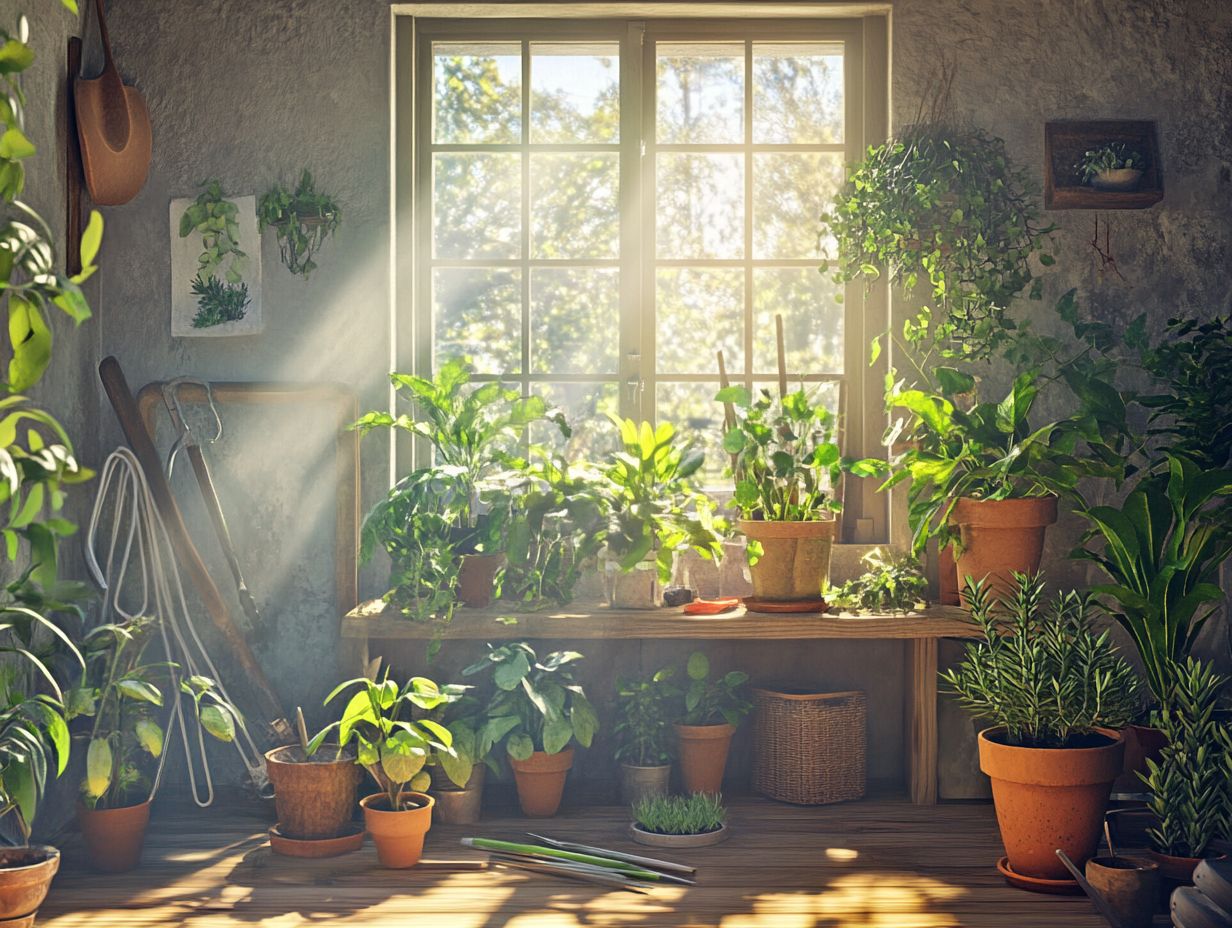
A balanced, general-purpose fertilizer is typically the best choice. Look for one with equal amounts of nitrogen, phosphorus, and potassium, as well as trace minerals. You can also use organic fertilizers like compost or worm castings for a natural approach.
Is Pruning Necessary for Faster Growth?
Pruning can encourage new growth and keep your plants healthy. Remove any dead or damaged leaves and stems, as well as any overcrowded or leggy growth. This allows your plant to focus its energy on new growth.
Can I Use Artificial Light to Help My Indoor Plants Grow Faster?
Yes, artificial light, such as grow lights, can help your indoor plants grow faster. Indoor plants typically need at least 8-12 hours of light per day. If they are not getting enough natural light, supplementing with artificial light can be beneficial. Adjust the distance and duration of the light based on your specific plant’s needs.
How Often Should I Water My Indoor Plants?
Watering frequency depends on the type of plant and environmental conditions. It s best to water when the top inch of soil feels dry to the touch. Avoid overwatering, as this can lead to root rot and slow your plants’ growth.
What Common Mistakes Might Be Hindering My Indoor Plants’ Growth?
Common mistakes include over or underwatering, lack of nutrients, insufficient light, not enough room for roots to grow, and using the wrong type of soil. Research your plants’ specific needs and provide proper care to help them grow faster.

